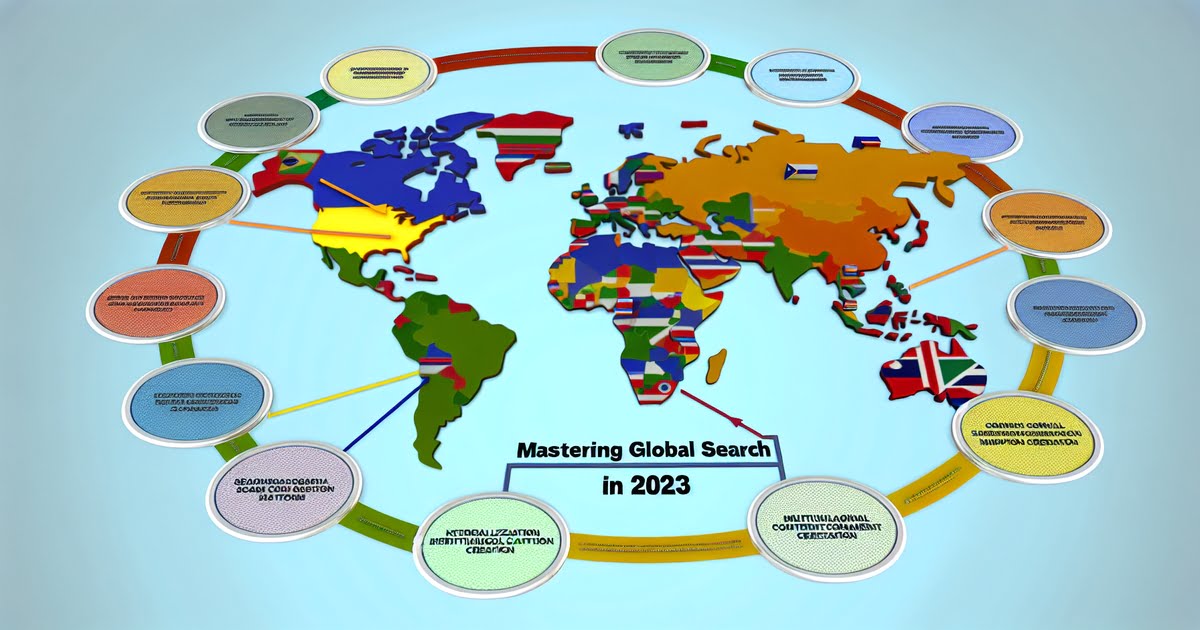Ever wonder how your business can tap into markets beyond your borders? Crafting savvy international SEO strategies is like holding the key to a global village of opportunities. In this digital era, borders are less of boundaries and more of mere markers on a map; with the right approach, you can ensure that language barriers and cultural differences don’t stand in the way of your website’s worldwide success. This post will guide you through essential tactics to elevate your online presence across continents, helping search engines and users alike find and favor your content no matter where they’re searching from. Let’s dive straight into turning the world into your playground.
Key Takeaways
International SEO is crucial for businesses looking to expand their online presence globally; it involves optimizing your website to attract traffic from different countries and languages.
Implement best practices such as using hreflang tags, optimizing for local search engines, and ensuring your site is mobile-friendly to improve global website visibility.
Develop a strategic framework by conducting thorough market research, identifying target countries, and aligning your SEO efforts with local cultural nuances and search behaviors.
Choose the right domain structure, such as ccTLDs, subdomains, or subdirectories, to signal to search engines the geographical targeting of your content.
Adapt your content culturally to resonate with local audiences, including translations and localizations that consider linguistic nuances, societal norms, and regional trends.
Regularly measure and analyze your international SEO performance using analytics tools to track rankings, traffic, and conversions; adjust strategies as needed for continual improvement.
Defining International SEO and Its Significance
Global Reach
SEO, or Search Engine Optimization, is crucial for businesses aiming to connect with customers worldwide. It’s the process of tweaking your website so people from different countries can find it easily online.
Imagine a store that only locals know about. Only those who walk by can visit it. Now think of SEO as a signpost in many languages, guiding people from all over to the store. That’s what international SEO does; it puts up digital signposts for your business around the world.
Business Growth
International SEO opens doors to new markets and opportunities for growth. By targeting specific regions, you can tailor your content to resonate with local cultures and preferences.
For example, if you sell winter gear, optimizing your site for countries with cold climates could boost sales during their winter months. This strategy makes sure that when someone in Norway searches “warmest winter jackets,” they might see your store first in their search results.
Competitive Edge
Effective international SEO gives you an edge over competitors not using these strategies. It helps set apart businesses that are ready to meet global demands versus those only catering locally.
Think about two shops selling similar handmade pottery—one optimizes its website internationally while the other doesn’t bother much beyond its city limits. The first shop will likely attract pottery lovers from across continents while the second remains unknown outside its neighborhood.
Best Practices for Global Website Optimization
Site Speed
Fast loading times are crucial. Users worldwide expect quick access to information. A slow site can lead to lost visitors and reduced engagement.
To improve speed, compress images and use a content delivery network (CDN). CDNs distribute your data globally, so it’s closer to users no matter where they are. This means faster load times for everyone.
Another tip is to minimize the use of heavy scripts or plugins that may slow down your site. Keep things lean and efficient.
Mobile Optimization
Most global internet traffic now comes from mobile devices. Your website must work well on smartphones and tablets.
Responsive design ensures your site looks good on any screen size. It also improves user experience which is key for keeping people on your site longer.
Make buttons large enough for thumbs! Small links are hard to tap on a phone, causing frustration.
Language Targeting
Language targeting helps speak directly to different audiences. The hreflang tag tells search engines which language you’re using on a specific page.
For example, if you have an English page and a Spanish one, hreflang tags guide Spanish speakers to the correct version of your site.
This avoids confusion and makes sure users get content in their own language.
Brand Messaging
Your brand message should be clear across all regions. However, cultural nuances mean messaging might need tweaking per market.
Research local customs and values when crafting messages. What works in one country might not resonate in another.
Consistency doesn’t mean identical; adapt while maintaining core brand values.
Remember these tips:
Optimize load speeds with CDNs,
Use responsive design,
Implement hreflang tags correctly,
Adapt brand messaging with local culture in mind.
Developing a Strategic Framework for International SEO
Target Identification
To start, identify which countries and languages your business will focus on. This step is crucial. It shapes the rest of your strategy. Look at where current traffic comes from. Also, consider market potential and competition.
Next, learn about each target country’s culture and search habits. For example, in Japan, Yahoo! might be more popular than Google. So you would adjust your strategy accordingly.
Understanding Domain Structures in Global SEO
ccTLDs Benefits
ccTLDs, or country code top-level domains, are specific to individual countries. For example, “.uk” for the United Kingdom or “.jp” for Japan. Using a ccTLD can signal search engines that your content is tailored for a particular region.
Boosts local relevance: A ccTLD directly associates your site with a certain country.
Enhances user trust: Users often prefer sites with their country’s domain extension.
However, managing multiple ccTLDs requires more resources and effort. You must maintain several websites instead of one.
Subdirectories Pros
Subdirectories add a specific folder to your existing domain to target different regions or languages, like “/us/” for the United States section of your website. They are easier to manage because they’re part of the same domain.
Simplifies management: Only one domain needs updating and monitoring.
Concentrates authority: All regional pages benefit from the main domain’s credibility.
But subdirectories might not be as effective in signaling regional content compared to ccTLDs due to less obvious geo-targeting cues.
Subdomains Impact
Using subdomains for international targeting involves creating separate “third-level” domains such as “us.example.com”. This approach falls between using ccTLDs and subdirectories regarding both control and complexity.
Pros:
Flexibility: Each subdomain can have its own content strategy.
Customization: Allows unique design and functionality per region.
Cons:
Split authority: Search engines may treat them almost like separate websites.
Brand dilution: Not as straightforwardly connected to the main brand as subdirectories are.
While each method has merits, it’s crucial how you implement them within your global SEO strategy that counts most towards search engine rankings globally.
Ranking Considerations
Search engines strive to provide users with relevant results based on location and language preferences. The choice between using ccTLDs, subdomains, or subdirectories can influence these outcomes significantly:
Local signals: Search engines use domain structure as clues about who should see your site.
A well-chosen structure helps ensure that visitors from targeted regions find you when they need what you offer.
Cultural Adaptation and Content Optimization
Local Customs
When expanding your website globally, cultural adaptation is vital. Tailoring content to local customs means more than just translating words. It’s about connecting with the audience in a way that feels familiar and respectful.
For instance, colors have different meanings across cultures. Red may signify luck in China but danger elsewhere. Your website’s color scheme should reflect such nuances to resonate with locals.
Technical Implementation of International SEO Elements
Structured Data
Structured data is a must for international sites. It helps search engines understand content context. Use schema markup to indicate different languages and regions.
Start by adding hreflang tags to your webpages. These tell Google which language you’re using on a specific page, so the right users find it. For example, an “en-gb” tag shows that the content is meant for English speakers in Great Britain.
Remember, each language version must have its own URL. This could be a subdomain or a separate domain entirely.
Link Building and Social Signals Across Borders
Region-Specific Links
Building a strong link profile is crucial for SEO success. But when targeting multiple countries, it’s important to get backlinks from websites that are authoritative within those specific regions. These regional sites signal to search engines that your content is relevant in those areas.
To start, research popular local directories or forums where you can list your website. Also, consider guest posting on popular blogs in the target region. This not only provides a valuable backlink but also exposes your brand to a new audience.
Leveraging Social Media
Social media platforms vary greatly by country. While Facebook and Twitter might be dominant in one region, others may prefer networks like VKontakte in Russia or Sina Weibo in China. Understanding which platforms are most used by your target audience can help tailor your social strategy effectively.
Create profiles on these key platforms and share content that resonates with local users. Engage with them through comments and messages to build relationships and brand trust.
Influencer Partnerships
Local influencers can dramatically boost your international SEO efforts. They have the power to amplify your message within their community quickly and credibly due to their established trust among followers.
Collaborate with influencers who align with your brand values for sponsored posts or endorsements. Their mention of your product or service often includes a link back to your site, enhancing link authority significantly.
Measuring and Analyzing International SEO Success
Ranking Tracking
Tracking rankings is key in international SEO. You must know how your site ranks in different countries. Use tools like Ahrefs or SEMrush for this task. They show where you rank on Google’s results pages across the globe.
A business might rank well in the USA but not in France. By tracking, they can see this issue and work to fix it. It’s about knowing where you stand so you can improve.
Final Remarks
Diving into international SEO is like unlocking a treasure chest for your business—huge potential if you’ve got the right map. We’ve navigated through crucial strategies, from optimizing your global website to understanding domain structures and cultural nuances. It’s all about making sure your content speaks everyone’s language and that search engines favor your global presence. Think of it as setting up shop in every corner of the world without leaving your desk.
So, what’s next? Take these insights, roll up your sleeves, and start scaling those international markets. Remember, the web’s your oyster, and you’re after those pearls. Check your analytics, tweak as needed, and watch your brand go viral across borders. Ready for world domination? Get cracking on that global SEO strategy and make some noise! Your audience awaits.
Frequently Asked Questions
What is International SEO and why is it important?
International SEO involves optimizing your website for different countries and languages. It’s crucial because it helps you reach a global audience effectively.
Can I use the same SEO strategies internationally as I do domestically?
Not always. While some principles apply globally, international SEO requires specific strategies like local keyword research and cultural adaptation.
What are the best practices for optimizing my website globally?
Focus on localized content, choose the right domain structure, and ensure technical elements like hreflang tags are correctly implemented.
How should I structure my domains for international audiences?
You can use country-specific domains (ccTLDs), subdomains, or subdirectories with gTLDs. The choice depends on your resources and business goals.
Why is cultural adaptation necessary in international SEO?
Cultural nuances affect user behavior. Tailoring content to fit local customs and preferences can significantly improve engagement and conversions.
What technical aspects should I consider for International SEO?
Implement hreflang tags, ensure site speed is optimized globally, and cater to local search engine preferences in each target market.
How do I measure the success of my international SEO efforts?
Track metrics like organic traffic from target regions, conversion rates by country/language, and SERP rankings for localized keywords.









